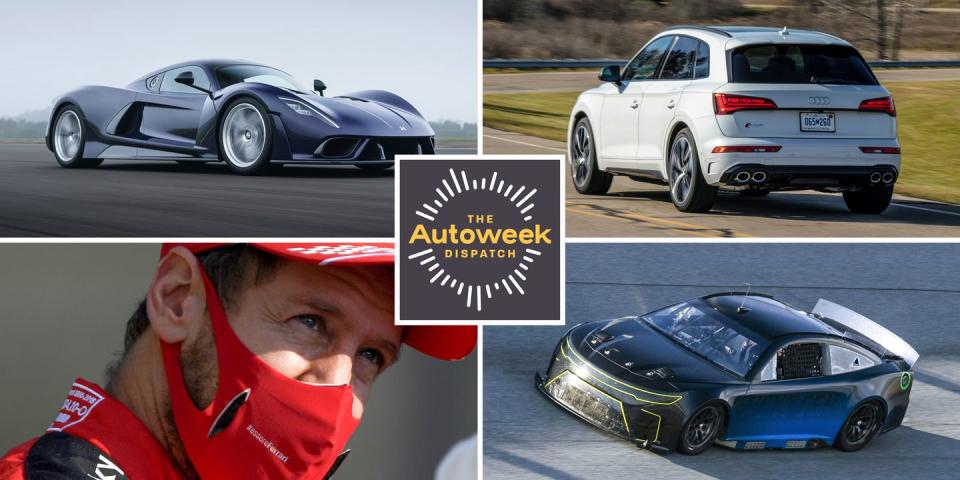Audi Updates Its Popular Q5

When we saw John Hennessey’s hypercar last week and heard the outlandish claims, we had to investigate further. So we did. And here’s what else is happening in the car world:
FROM THE EDITOR’S DESK
Earlier this week in the U.K., tuner-turned-carmaker John Hennessey revealed his latest “production” hypercar, the Venom F5. Mike Duff, our man in Europe, saw the car and saw it move under its own power. “It definitely isn’t vaporware,” he told us. For a quick recap, Hennessey says the Venom F5 — unlike his last production hypercar — is a new design with a unique carbon-fiber tub and a unique twin-turbo 6.6-liter pushrod V8 of his own design. He says it makes 1,817 hp and 1,193 lb-ft of torque, numbers we cannot verify. He also claims the goal with this car is to go 311 mph.
A few questions arise, to put it mildly.
For instance, what exactly constitutes a “production” car?
“I don’t think there is a recognized definition for a ‘production car’ (e.g., such as a volume requirement),” Hennessey spokesman Jon Visscher told Autoweek. “I know that some manufacturers of high-end hypercars make special editions of their production cars that can be counted on one hand. Hennessey will produce 24 of its F5 hypercars.”
Hennessey himself told Duff earlier he might make 100 cars a year. So “production” volume isn’t clear. Hennessey did deliver 12 Venom GTs to customers, one of them famously sold to Aerosmith frontman Steven Tyler.
We also had a few questions about the new car’s safety. Visscher told us Hennessey has conducted all the required FEA simulations for crashworthiness and that the F5 will meet the “required safety standards” in every market where it’s sold. He also claimed the F5’s carbon-fiber monocoque is “one of the most rigid produced by any automotive manufacturer.”
“The intrinsic strength of carbon fiber enhances occupant safety in the event of an accident,” he told us. “The carbon-fiber body joins an aluminum subframe where engine and suspension components connect. The subframe components are engineered to deform in the event of an accident to absorb the energy of an impact and protect the passenger cell.”
Nonetheless, the Venom F5 won’t meet the same safety standards as other production passenger cars from major manufacturers in the U.S. It has no airbags, for instance. The plan now is that customers will register their Venoms under NHTSA’s special “Show & Display” rule. It’s also possible Hennessey could register his company under the Low Volume Motor Vehicle Manufacturers Act, part of the FAST Act, from 2015.
Then there’s the question of tires. If Hennessey hopes to go 311 mph in this thing, consider that your average street tire would disintegrate at that speed.
“The team has worked closely with Michelin’s engineers from the beginning,” Visscher assured us. “The Hennessey engineering team, led by John Heinricy (former General Motors Performance Division director), will monitor countless data sets as the car continues its development — including its Pilot Sport Cup 2 tires — and will always work within the safety parameters set forth by Michelin’s engineers.”
Nonetheless the commercially available Pilot Sport Cup 2’s are good for only 186 mph.
“For Hennessey, Michelin is providing its Pilot Sport Cup 2 tire,” said Visscher. “As part of the development process for the F5, Michelin will evaluate the tire on its aircraft test rig that can test tires at up to 400 mph. This test, along with data gathered throughout the vehicle’s development phase, will ensure the tires are tested to perform at the speeds the F5 is capable of. If at any stage the Hennessey or Michelin engineers feel that limits are within sight, the performance level of the vehicle will be capped before customer deliveries are made. However, this is only a prudent precaution put in place by the Hennessey team. At this stage, the experts at Michelin are confident of the performance capabilities of their tire.”
We tracked down Heinricy and he laid out for us the work he and the team did on the car:
“I looked in detail at all the requirements for the F5,” said Heinricy. “From styling to unsprung and sprung mass, adjustability, powertrain packaging, chassis stiffness, tire and wheel sizes, aerodynamics and all the performance requirements, i.e., agile handling, top speed, acceleration, to track packs, and then the team worked out the suspension layout, geometries, compliances, etc., to best meet all the requirements. I based this on my experience with engineering many GM road cars, as well as race cars, that I have been involved with throughout my career. Designing a completely bespoke car made this possible.”
Heinricy was particularly proud of the car’s hydraulics.
“The hydraulic lift is an important enabler for handling response and agility because we can run a lower ride height and then lift the car for obstacles,” he told us. “And secondly, the Penske four-way adjustable shocks, with low- and high-frequency adjustability in both jounce and rebound, gives great control bandwidth without harshness.”

 Yahoo Autos
Yahoo Autos 